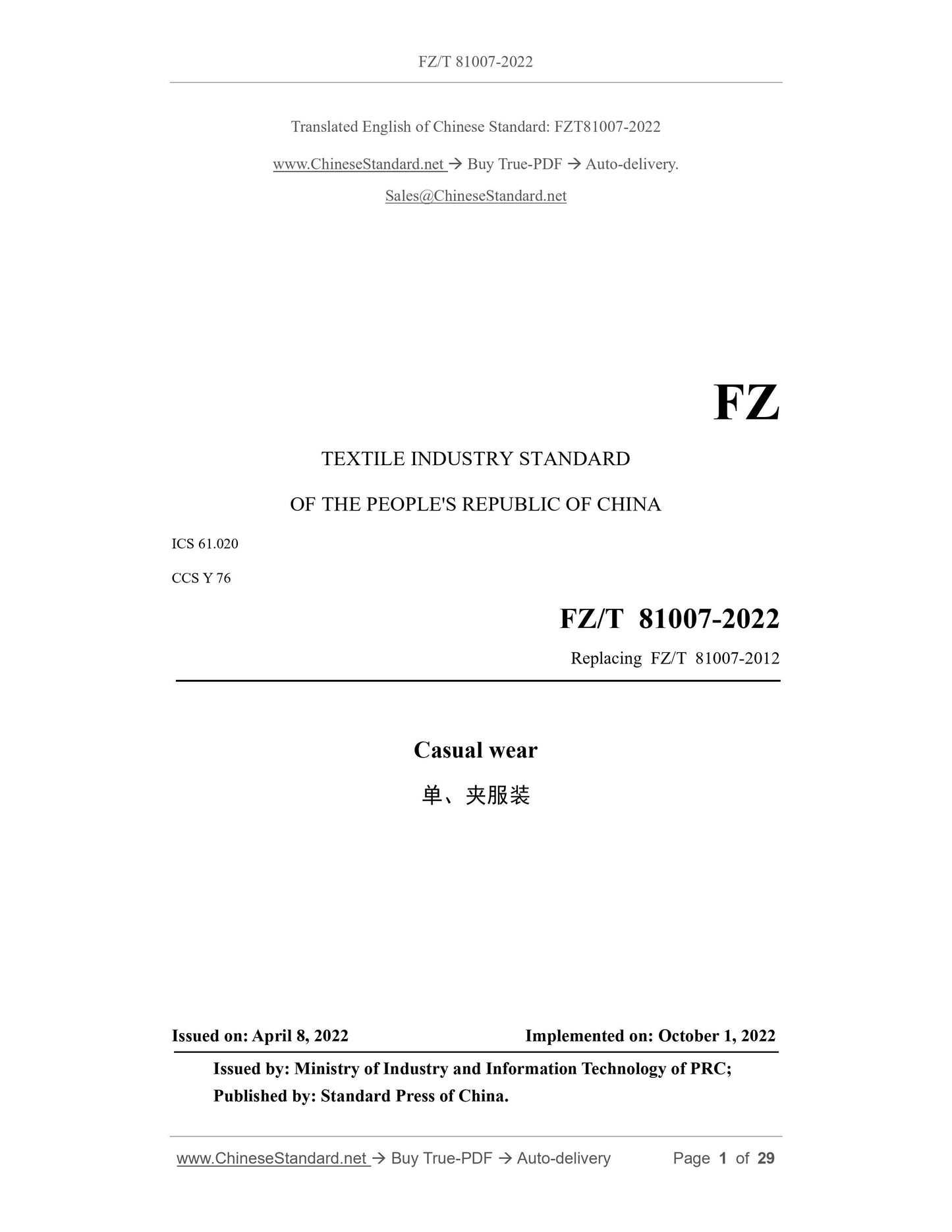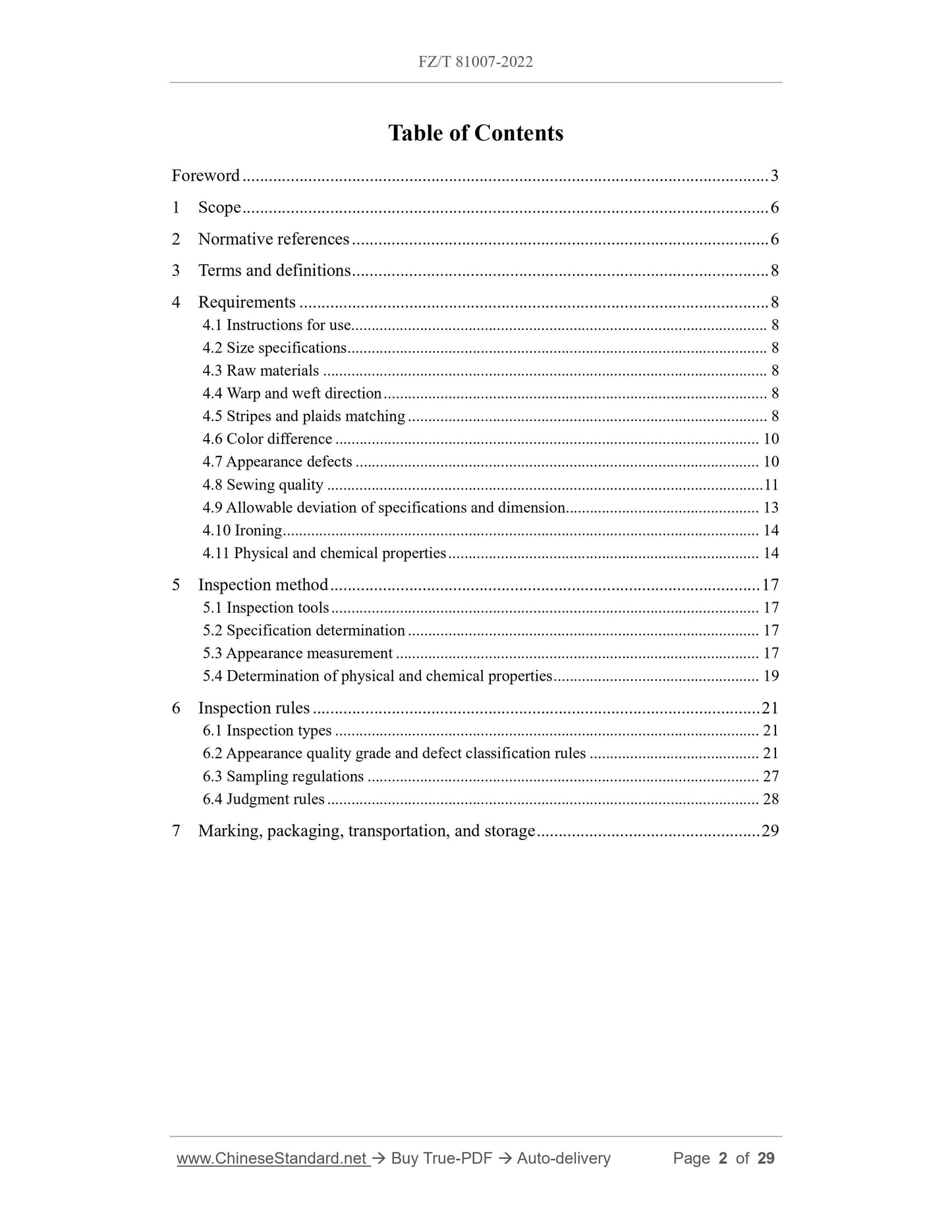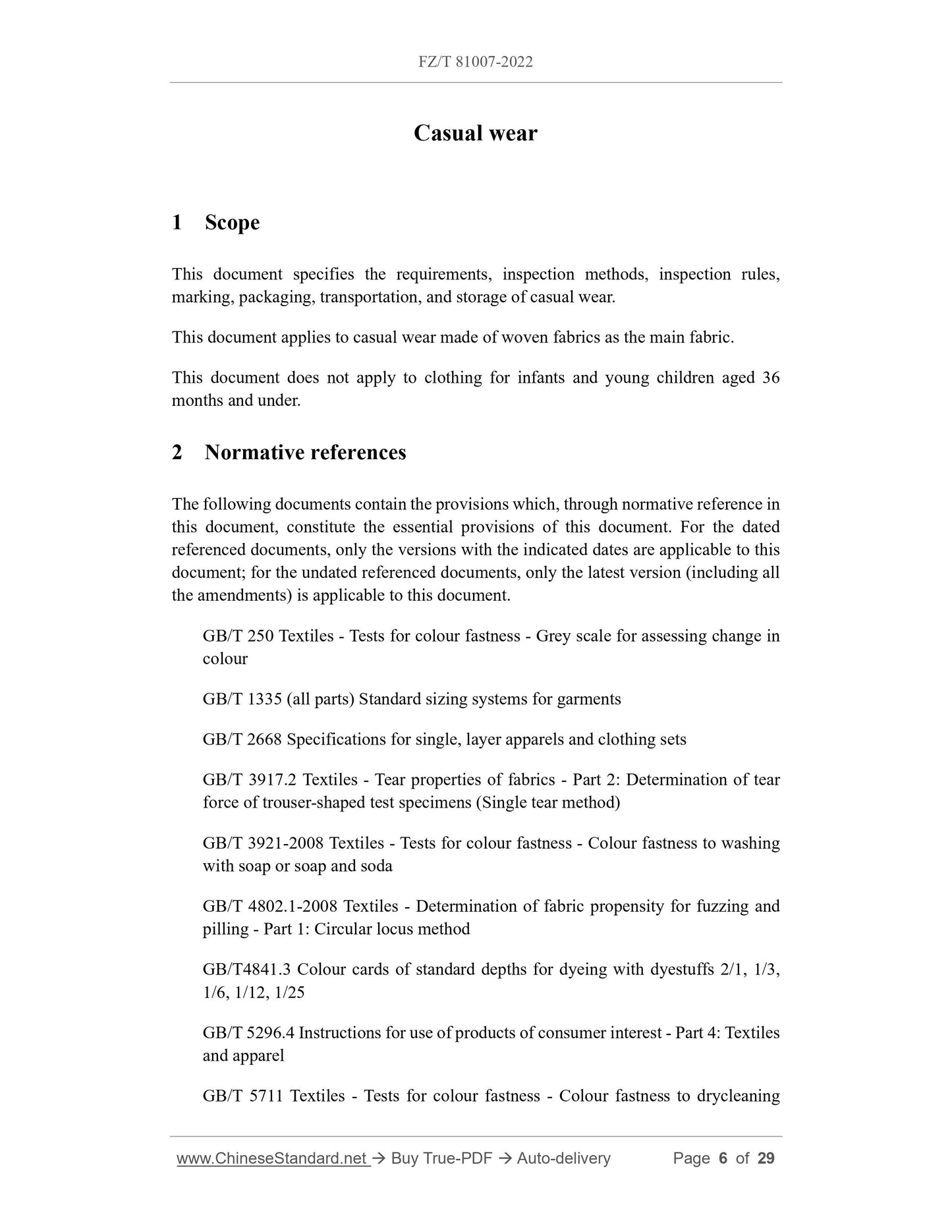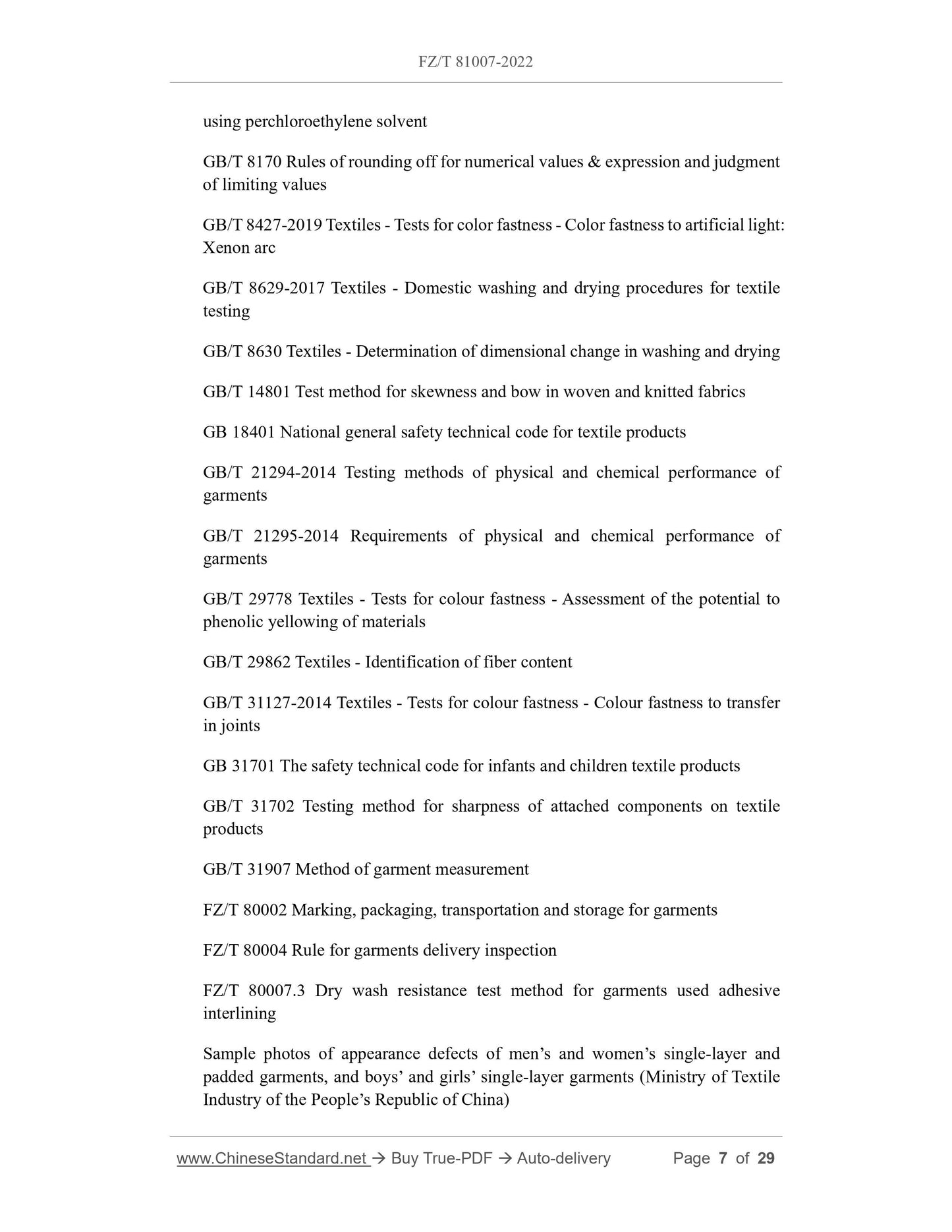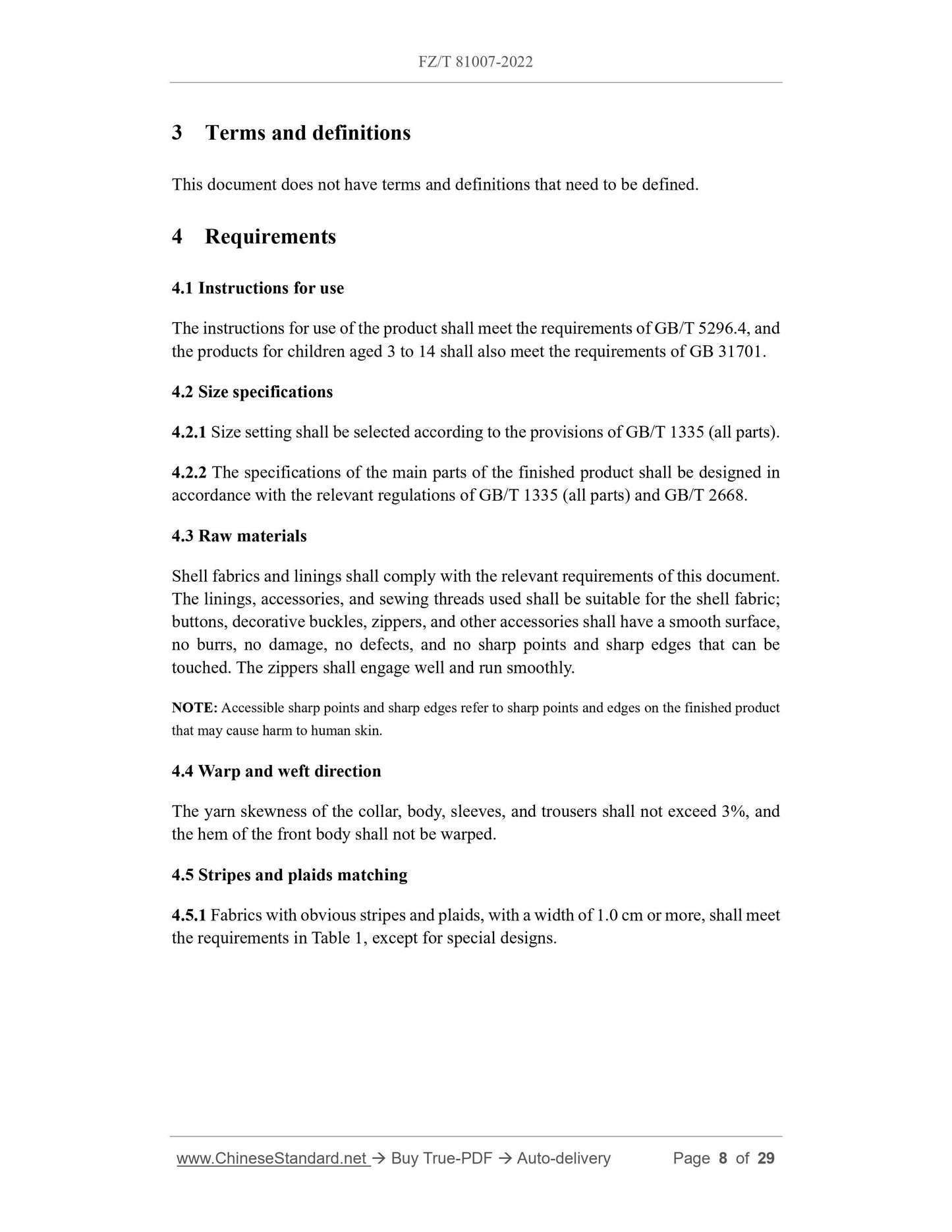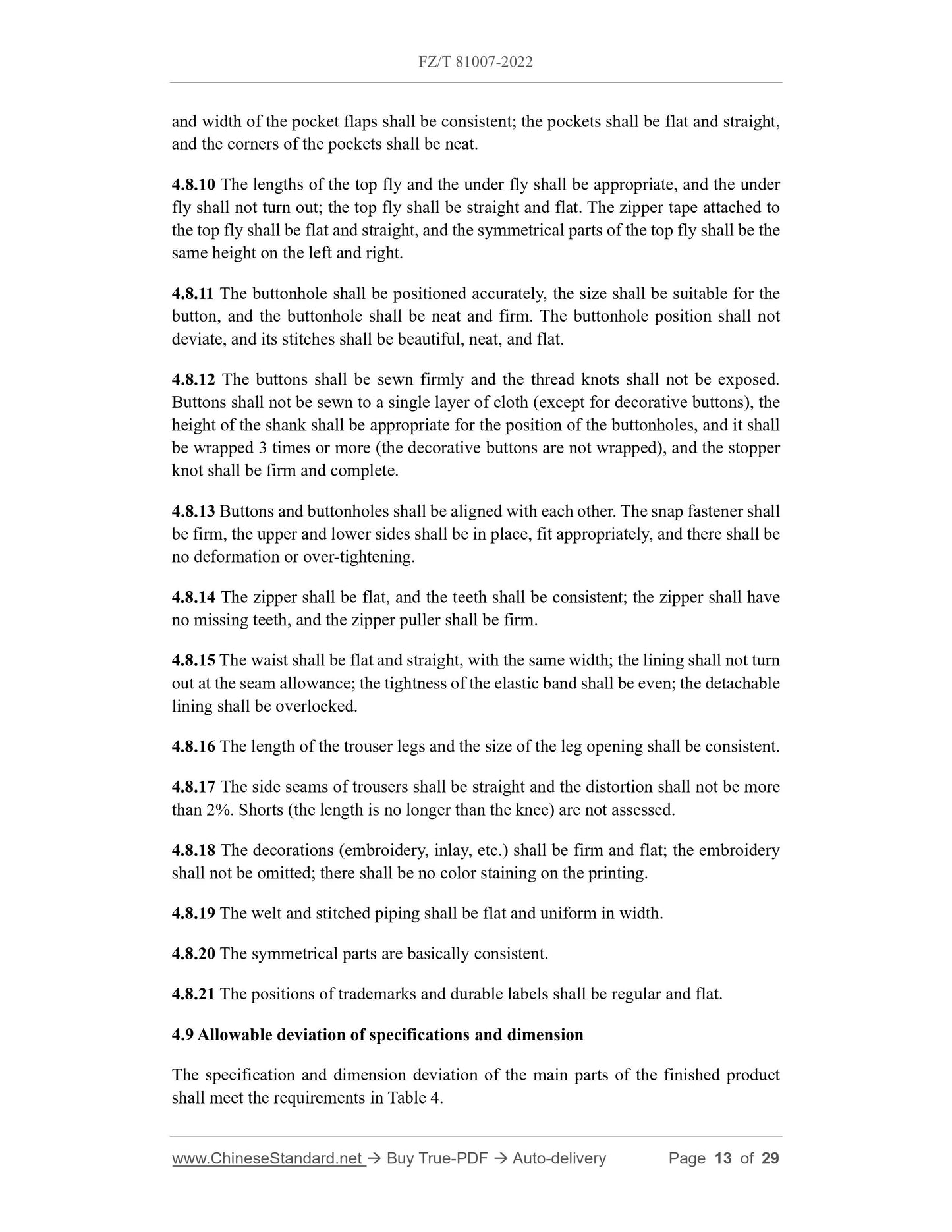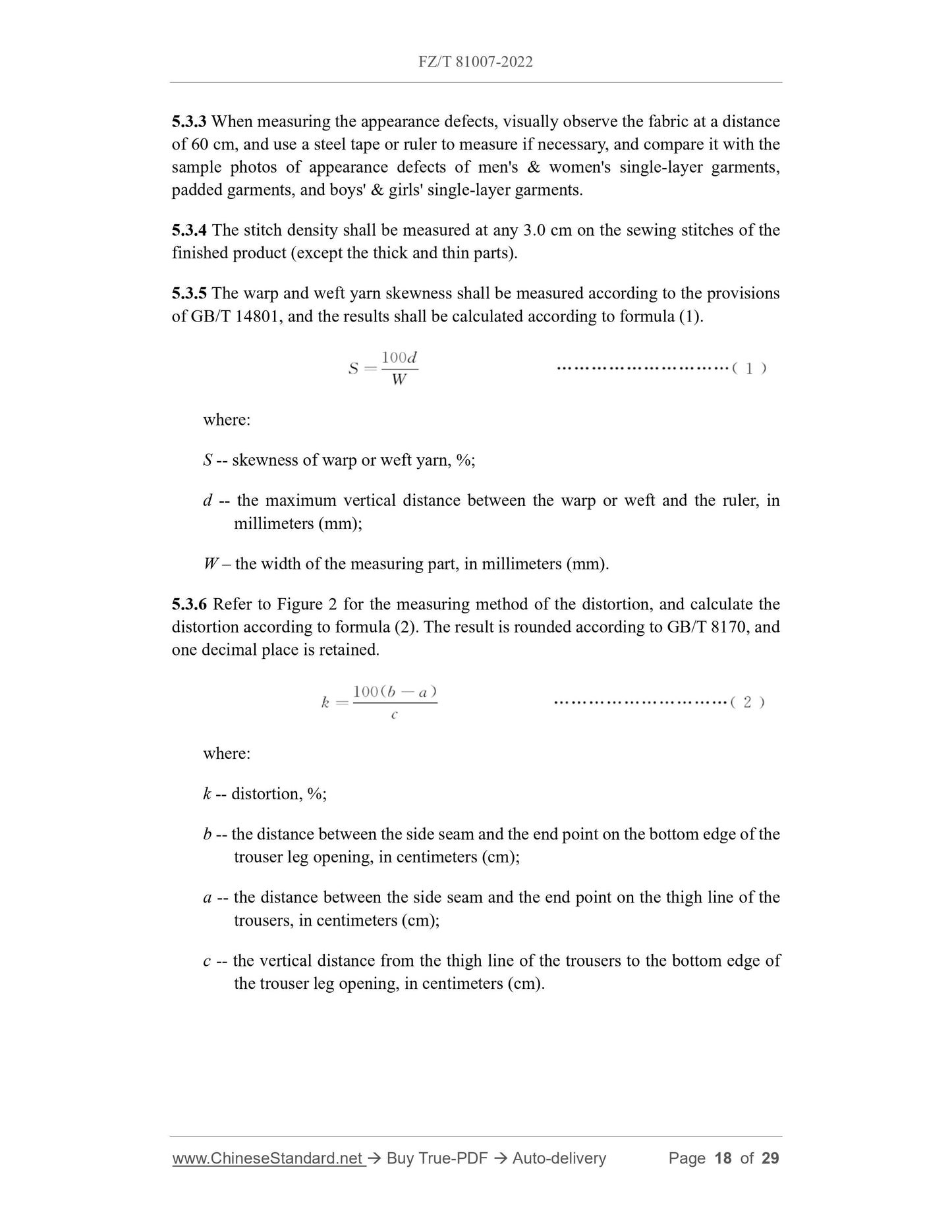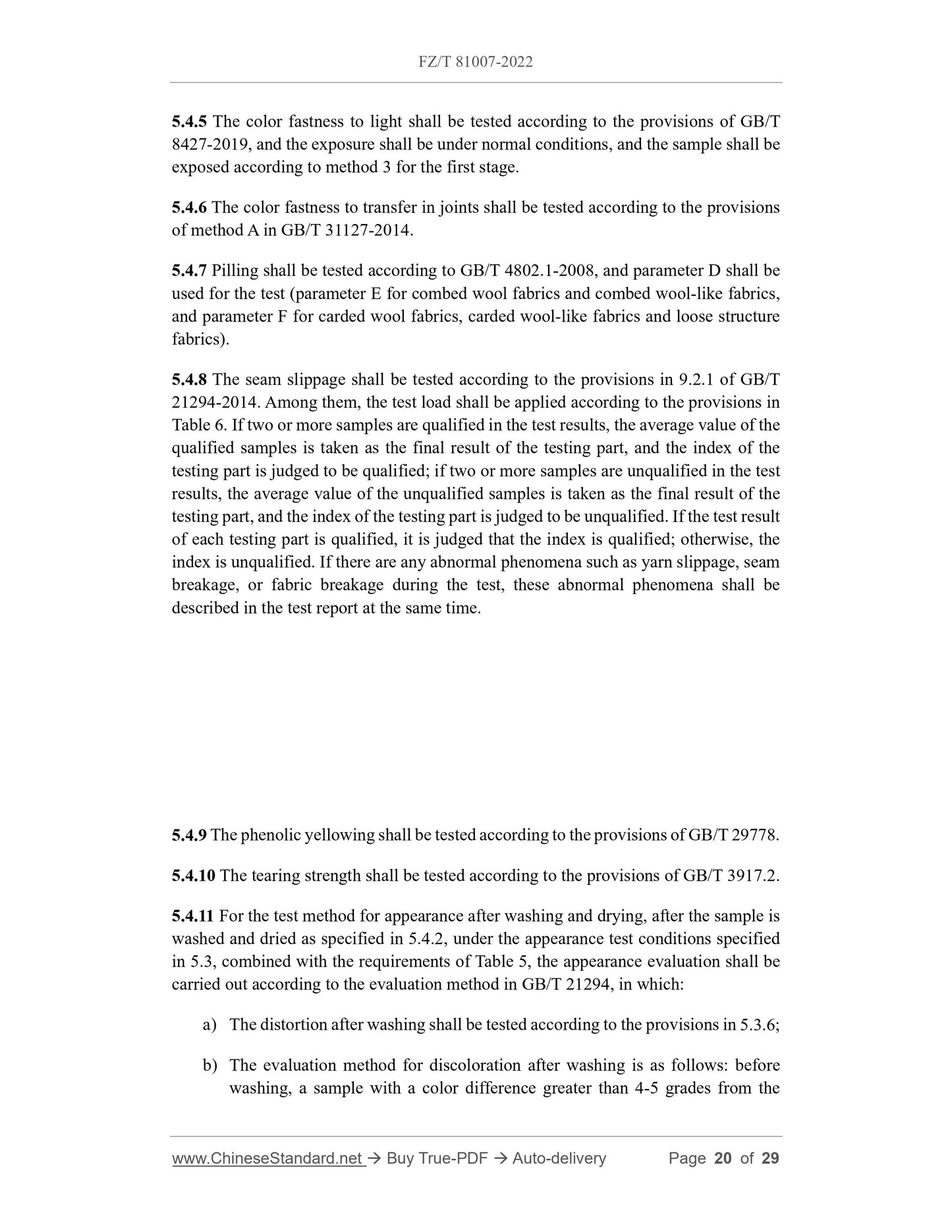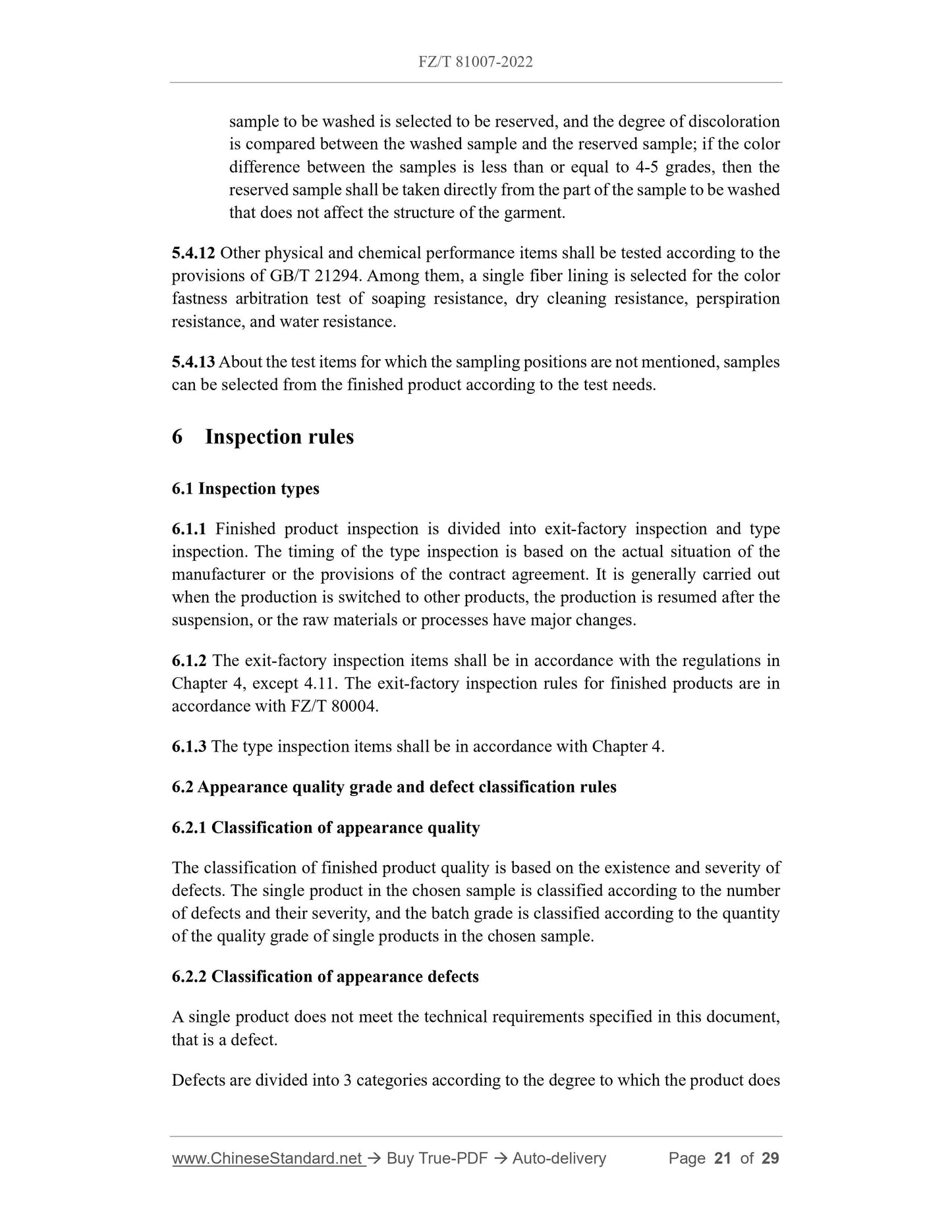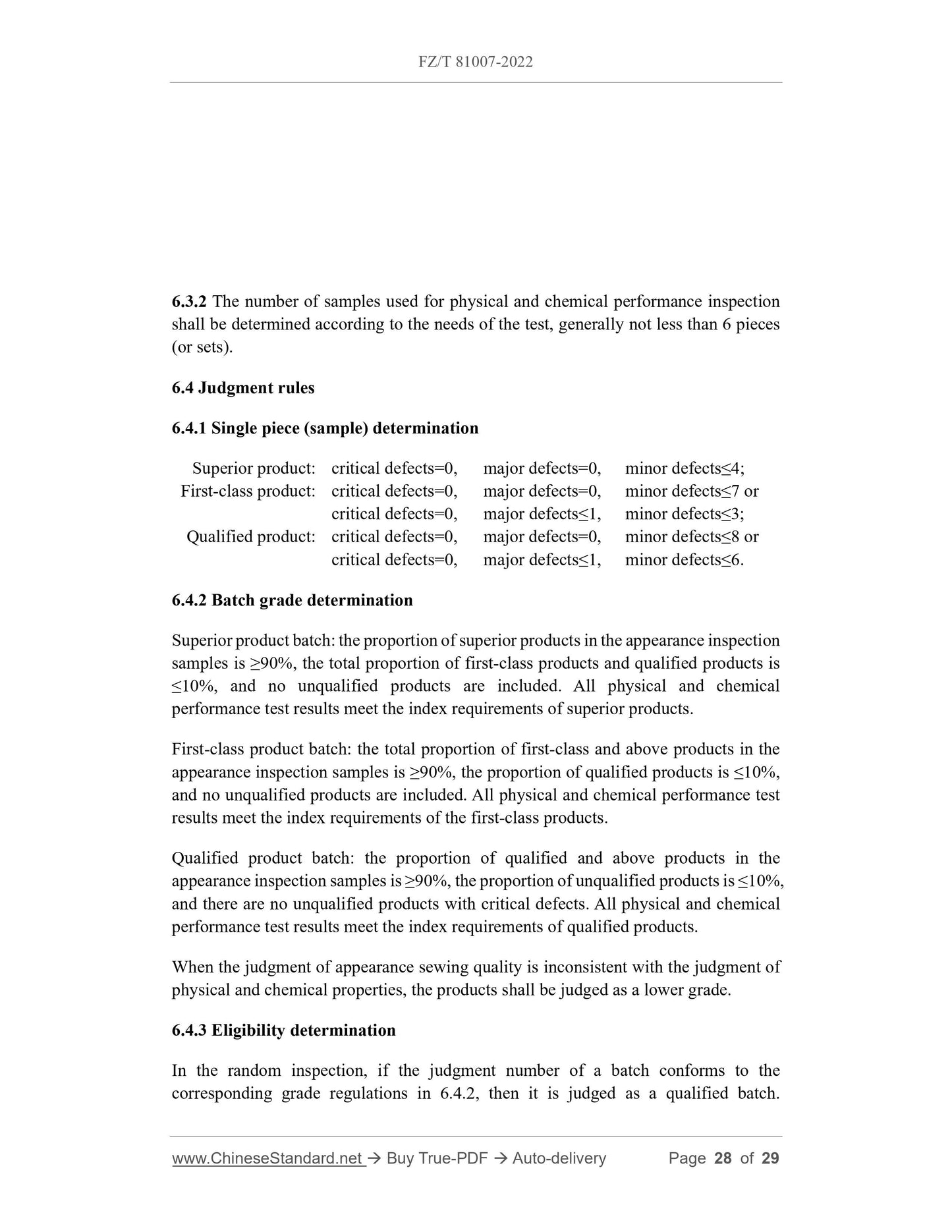PayPal, credit cards. Download editable-PDF & invoice In 1 second!
FZ/T 81007-2022 English PDF (FZT81007-2022)
FZ/T 81007-2022 English PDF (FZT81007-2022)
Precio habitual
$245.00 USD
Precio habitual
Precio de oferta
$245.00 USD
Precio unitario
/
por
Los gastos de envío se calculan en la pantalla de pago.
No se pudo cargar la disponibilidad de retiro
Delivery: 3 seconds. Download true-PDF + Invoice.
Get QUOTATION in 1-minute: Click FZ/T 81007-2022
Historical versions: FZ/T 81007-2022
Preview True-PDF (Reload/Scroll if blank)
FZ/T 81007-2022: Casual wear
FZ/T 81007-2022
FZ
TEXTILE INDUSTRY STANDARD
OF THE PEOPLE'S REPUBLIC OF CHINA
ICS 61.020
CCS Y 76
Replacing FZ/T 81007-2012
Casual wear
单, 夹服装
ISSUED ON: APRIL 8, 2022
IMPLEMENTED ON: OCTOBER 1, 2022
Issued by: Ministry of Industry and Information Technology of PRC;
Published by: Standard Press of China.
Table of Contents
Foreword ... 3
1 Scope ... 6
2 Normative references ... 6
3 Terms and definitions ... 8
4 Requirements ... 8
4.1 Instructions for use ... 8
4.2 Size specifications ... 8
4.3 Raw materials ... 8
4.4 Warp and weft direction ... 8
4.5 Stripes and plaids matching ... 8
4.6 Color difference ... 10
4.7 Appearance defects ... 10
4.8 Sewing quality ... 11
4.9 Allowable deviation of specifications and dimension ... 13
4.10 Ironing ... 14
4.11 Physical and chemical properties ... 14
5 Inspection method ... 17
5.1 Inspection tools ... 17
5.2 Specification determination ... 17
5.3 Appearance measurement ... 17
5.4 Determination of physical and chemical properties ... 19
6 Inspection rules ... 21
6.1 Inspection types ... 21
6.2 Appearance quality grade and defect classification rules ... 21
6.3 Sampling regulations ... 27
6.4 Judgment rules ... 28
7 Marking, packaging, transportation, and storage ... 29
Casual wear
1 Scope
This document specifies the requirements, inspection methods, inspection rules,
marking, packaging, transportation, and storage of casual wear.
This document applies to casual wear made of woven fabrics as the main fabric.
This document does not apply to clothing for infants and young children aged 36
months and under.
2 Normative references
The following documents contain the provisions which, through normative reference in
this document, constitute the essential provisions of this document. For the dated
referenced documents, only the versions with the indicated dates are applicable to this
document; for the undated referenced documents, only the latest version (including all
the amendments) is applicable to this document.
GB/T 250 Textiles - Tests for colour fastness - Grey scale for assessing change in
colour
GB/T 1335 (all parts) Standard sizing systems for garments
GB/T 2668 Specifications for single, layer apparels and clothing sets
GB/T 3917.2 Textiles - Tear properties of fabrics - Part 2: Determination of tear
force of trouser-shaped test specimens (Single tear method)
GB/T 3921-2008 Textiles - Tests for colour fastness - Colour fastness to washing
with soap or soap and soda
GB/T 4802.1-2008 Textiles - Determination of fabric propensity for fuzzing and
pilling - Part 1: Circular locus method
GB/T4841.3 Colour cards of standard depths for dyeing with dyestuffs 2/1, 1/3,
1/6, 1/12, 1/25
GB/T 5296.4 Instructions for use of products of consumer interest - Part 4: Textiles
and apparel
GB/T 5711 Textiles - Tests for colour fastness - Colour fastness to drycleaning
using perchloroethylene solvent
GB/T 8170 Rules of rounding off for numerical values and expression and judgment
of limiting values
GB/T 8427-2019 Textiles - Tests for color fastness - Color fastness to artificial light:
Xenon arc
GB/T 8629-2017 Textiles - Domestic washing and drying procedures for textile
testing
GB/T 8630 Textiles - Determination of dimensional change in washing and drying
GB/T 14801 Test method for skewness and bow in woven and knitted fabrics
GB 18401 National general safety technical code for textile products
GB/T 21294-2014 Testing methods of physical and chemical performance of
garments
GB/T 21295-2014 Requirements of physical and chemical performance of
garments
GB/T 29778 Textiles - Tests for colour fastness - Assessment of the potential to
phenolic yellowing of materials
GB/T 29862 Textiles - Identification of fiber content
GB/T 31127-2014 Textiles - Tests for colour fastness - Colour fastness to transfer
in joints
GB 31701 The safety technical code for infants and children textile products
GB/T 31702 Testing method for sharpness of attached components on textile
products
GB/T 31907 Method of garment measurement
FZ/T 80002 Marking, packaging, transportation and storage for garments
FZ/T 80004 Rule for garments delivery inspection
FZ/T 80007.3 Dry wash resistance test method for garments used adhesive
interlining
Sample photos of appearance defects of men’s and women’s single-layer and
padded garments, and boys’ and girls’ single-layer garments (Ministry of Textile
Industry of the People’s Republic of China)
3 Terms and definitions
This document does not have terms and definitions that need to be defined.
4 Requirements
4.1 Instructions for use
The instructions for use of the product shall meet the requirements of GB/T 5296.4, and
the products for children aged 3 to 14 shall also meet the requirements of GB 31701.
4.2 Size specifications
4.2.1 Size setting shall be selected according to the provisions of GB/T 1335 (all parts).
4.2.2 The specifications of the main parts of the finished product shall be designed in
accordance with the relevant regulations of GB/T 1335 (all parts) and GB/T 2668.
4.3 Raw materials
Shell fabrics and linings shall comply with the relevant requirements of this document.
The linings, accessories, and sewing threads used shall be suitable for the shell fabric;
buttons, decorative buckles, zippers, and other accessories shall have a smooth surface,
no burrs, no damage, no defects, and no sharp points and sharp edges that can be
touched. The zippers shall engage well and run smoothly.
NOTE: Accessible sharp points and sharp edges refer to sharp points and edges on the finished product
that may cause harm to human skin.
4.4 Warp and weft direction
The yarn skewness of the collar, body, sleeves, and trousers shall not exceed 3%, and
the hem of the front body shall not be warped.
4.5 Stripes and plaids matching
4.5.1 Fabrics with obvious stripes and plaids, with a width of 1.0 cm or more, shall meet
the requirements in Table 1, except for special designs.
and width of the pocket flaps shall be consistent; the pockets shall be flat and straight,
and the corners of the pockets shall be neat.
4.8.10 The lengths of the top fly and the under fly shall be appropriate, and the under
fly shall not turn out; the top fly shall be straight and flat. The zipper tape attached to
the top fly shall be flat and straight, and the symmetrical parts of the top fly shall be the
same height on the left and right.
4.8.11 The buttonhole shall be positioned accurately, the size shall be suitable for the
button, and the buttonhole shall be neat and firm. The buttonhole position shall not
deviate, and its stitches shall be beautiful, neat, and flat.
4.8.12 The buttons shall be sewn firmly and the thread knots shall not be exposed.
Buttons shall not be sewn to a single layer of cloth (except for decorative buttons), the
height of the shank shall be appropriate for the position of the buttonholes, and it shall
be wrapped 3 times or more (the decorative buttons are not wrapped), and the stopper
knot shall be firm and complete.
4.8.13 Buttons and buttonholes shall be aligned with each other. The snap fastener shall
be firm, the upper and lower sides shall be in place, fit appropriately, and there shall be
no deformation or over-tightening.
4.8.14 The zipper shall be flat, and the teeth shall be consistent; the zipper shall have
no missing teeth, and the z...
Get QUOTATION in 1-minute: Click FZ/T 81007-2022
Historical versions: FZ/T 81007-2022
Preview True-PDF (Reload/Scroll if blank)
FZ/T 81007-2022: Casual wear
FZ/T 81007-2022
FZ
TEXTILE INDUSTRY STANDARD
OF THE PEOPLE'S REPUBLIC OF CHINA
ICS 61.020
CCS Y 76
Replacing FZ/T 81007-2012
Casual wear
单, 夹服装
ISSUED ON: APRIL 8, 2022
IMPLEMENTED ON: OCTOBER 1, 2022
Issued by: Ministry of Industry and Information Technology of PRC;
Published by: Standard Press of China.
Table of Contents
Foreword ... 3
1 Scope ... 6
2 Normative references ... 6
3 Terms and definitions ... 8
4 Requirements ... 8
4.1 Instructions for use ... 8
4.2 Size specifications ... 8
4.3 Raw materials ... 8
4.4 Warp and weft direction ... 8
4.5 Stripes and plaids matching ... 8
4.6 Color difference ... 10
4.7 Appearance defects ... 10
4.8 Sewing quality ... 11
4.9 Allowable deviation of specifications and dimension ... 13
4.10 Ironing ... 14
4.11 Physical and chemical properties ... 14
5 Inspection method ... 17
5.1 Inspection tools ... 17
5.2 Specification determination ... 17
5.3 Appearance measurement ... 17
5.4 Determination of physical and chemical properties ... 19
6 Inspection rules ... 21
6.1 Inspection types ... 21
6.2 Appearance quality grade and defect classification rules ... 21
6.3 Sampling regulations ... 27
6.4 Judgment rules ... 28
7 Marking, packaging, transportation, and storage ... 29
Casual wear
1 Scope
This document specifies the requirements, inspection methods, inspection rules,
marking, packaging, transportation, and storage of casual wear.
This document applies to casual wear made of woven fabrics as the main fabric.
This document does not apply to clothing for infants and young children aged 36
months and under.
2 Normative references
The following documents contain the provisions which, through normative reference in
this document, constitute the essential provisions of this document. For the dated
referenced documents, only the versions with the indicated dates are applicable to this
document; for the undated referenced documents, only the latest version (including all
the amendments) is applicable to this document.
GB/T 250 Textiles - Tests for colour fastness - Grey scale for assessing change in
colour
GB/T 1335 (all parts) Standard sizing systems for garments
GB/T 2668 Specifications for single, layer apparels and clothing sets
GB/T 3917.2 Textiles - Tear properties of fabrics - Part 2: Determination of tear
force of trouser-shaped test specimens (Single tear method)
GB/T 3921-2008 Textiles - Tests for colour fastness - Colour fastness to washing
with soap or soap and soda
GB/T 4802.1-2008 Textiles - Determination of fabric propensity for fuzzing and
pilling - Part 1: Circular locus method
GB/T4841.3 Colour cards of standard depths for dyeing with dyestuffs 2/1, 1/3,
1/6, 1/12, 1/25
GB/T 5296.4 Instructions for use of products of consumer interest - Part 4: Textiles
and apparel
GB/T 5711 Textiles - Tests for colour fastness - Colour fastness to drycleaning
using perchloroethylene solvent
GB/T 8170 Rules of rounding off for numerical values and expression and judgment
of limiting values
GB/T 8427-2019 Textiles - Tests for color fastness - Color fastness to artificial light:
Xenon arc
GB/T 8629-2017 Textiles - Domestic washing and drying procedures for textile
testing
GB/T 8630 Textiles - Determination of dimensional change in washing and drying
GB/T 14801 Test method for skewness and bow in woven and knitted fabrics
GB 18401 National general safety technical code for textile products
GB/T 21294-2014 Testing methods of physical and chemical performance of
garments
GB/T 21295-2014 Requirements of physical and chemical performance of
garments
GB/T 29778 Textiles - Tests for colour fastness - Assessment of the potential to
phenolic yellowing of materials
GB/T 29862 Textiles - Identification of fiber content
GB/T 31127-2014 Textiles - Tests for colour fastness - Colour fastness to transfer
in joints
GB 31701 The safety technical code for infants and children textile products
GB/T 31702 Testing method for sharpness of attached components on textile
products
GB/T 31907 Method of garment measurement
FZ/T 80002 Marking, packaging, transportation and storage for garments
FZ/T 80004 Rule for garments delivery inspection
FZ/T 80007.3 Dry wash resistance test method for garments used adhesive
interlining
Sample photos of appearance defects of men’s and women’s single-layer and
padded garments, and boys’ and girls’ single-layer garments (Ministry of Textile
Industry of the People’s Republic of China)
3 Terms and definitions
This document does not have terms and definitions that need to be defined.
4 Requirements
4.1 Instructions for use
The instructions for use of the product shall meet the requirements of GB/T 5296.4, and
the products for children aged 3 to 14 shall also meet the requirements of GB 31701.
4.2 Size specifications
4.2.1 Size setting shall be selected according to the provisions of GB/T 1335 (all parts).
4.2.2 The specifications of the main parts of the finished product shall be designed in
accordance with the relevant regulations of GB/T 1335 (all parts) and GB/T 2668.
4.3 Raw materials
Shell fabrics and linings shall comply with the relevant requirements of this document.
The linings, accessories, and sewing threads used shall be suitable for the shell fabric;
buttons, decorative buckles, zippers, and other accessories shall have a smooth surface,
no burrs, no damage, no defects, and no sharp points and sharp edges that can be
touched. The zippers shall engage well and run smoothly.
NOTE: Accessible sharp points and sharp edges refer to sharp points and edges on the finished product
that may cause harm to human skin.
4.4 Warp and weft direction
The yarn skewness of the collar, body, sleeves, and trousers shall not exceed 3%, and
the hem of the front body shall not be warped.
4.5 Stripes and plaids matching
4.5.1 Fabrics with obvious stripes and plaids, with a width of 1.0 cm or more, shall meet
the requirements in Table 1, except for special designs.
and width of the pocket flaps shall be consistent; the pockets shall be flat and straight,
and the corners of the pockets shall be neat.
4.8.10 The lengths of the top fly and the under fly shall be appropriate, and the under
fly shall not turn out; the top fly shall be straight and flat. The zipper tape attached to
the top fly shall be flat and straight, and the symmetrical parts of the top fly shall be the
same height on the left and right.
4.8.11 The buttonhole shall be positioned accurately, the size shall be suitable for the
button, and the buttonhole shall be neat and firm. The buttonhole position shall not
deviate, and its stitches shall be beautiful, neat, and flat.
4.8.12 The buttons shall be sewn firmly and the thread knots shall not be exposed.
Buttons shall not be sewn to a single layer of cloth (except for decorative buttons), the
height of the shank shall be appropriate for the position of the buttonholes, and it shall
be wrapped 3 times or more (the decorative buttons are not wrapped), and the stopper
knot shall be firm and complete.
4.8.13 Buttons and buttonholes shall be aligned with each other. The snap fastener shall
be firm, the upper and lower sides shall be in place, fit appropriately, and there shall be
no deformation or over-tightening.
4.8.14 The zipper shall be flat, and the teeth shall be consistent; the zipper shall have
no missing teeth, and the z...
Share
